Frost
As we all know the weather is very unpredictable so although its spring we can still get late frosts which can affect the health of your spring bulbs and flowers.
The only way to get around this is to try and keep a close eye on the weather forecast and protect vulnerable plants using horticulture fleece or cloches.
If you have read my winter blog tips you will remember I suggested mulching as a useful way to help against frost protection, which you can also do to help spring bulbs also by spreading compost onto newly sprouted stems.
Weeding
If you followed my advice from my last post you will have been keeping on top of the weeds that may have sprouted up over winter, however, as the ground warms up those pesky intruders will be beginning to pop up everywhere! Weeding regularly definitely helps reduce the amount of weeds that grow over time, however there are a couple of tools you can use to make the job a lot easier;
A dutch hoe is a brilliant tool for weeding large areas. Use this tool with the front pointing up and ‘rake’ the soil where there are weeds. Do this in a backwards and forwards motion and as you do make sure that the hoe goes underneath the surface of the soil by about an inch. This loosens the roots of the weeds and then you can use a rake or use your hands to gather up the weeds and dispose of them.
A hand cultivator looks very much like a claw that you hold in your hand. You can use it in a similar way to a dutch hoe, by raking the soil to loosen up the roots of the weeds, enabling you to quickly gather them up. This tool is particularly good for small or raised areas in the garden.
Knee protection when I kneel to weed I always wear knee pads. They have velcro fixings at the back so move around with me as I am working. I don’t use a cushion as I want to move around quickly and don’t want to have to remember to to pick it up and place it where I will be working next. It sounds like a small thing but when you are gardening, eliminating unnecessary fussing and working efficiently really help you to get jobs finished in less time and reduce stress on your body. You can buy great knee pads in gardening centres or across the internet and I highly recommend them.
Lawn maintenance
Spring is a great time to give your lawn some much needed attention and a great way to start is by removing moss with a rake, removing any weeds, and aerating (punching little holes in your lawn which allow airflow, water and nutrients to reach the grass roots) the soil. You can buy lawn aeration tools for a fairly good price online, however, I use my garden fork and make holes with the teeth allover the lawn by stabbing the ground. It is probably harder work this way but if you don’t have much shed space and fancy some exercise then its a good way to use what you’ve already got. The next job would be to add seeds to any bald patches and to give it some fertiliser to help nourish the soil. Depending on its growth you may also need to mow your lawn before you start any of these jobs.
Compost
One of the jobs that I do for almost every client at this time of year is the spreading of compost on their beds. After winter, soil is often lacking in nutrients, so I begin the growing season by spreading compost to add some much need nourishment. Recently we began spreading well rotted manure instead of compost for our clients, as it is more environmentally friendly. If you have stables nearby then pop up there and find out if they have any to dispose of but, a word of warning – always remember to rot fresh manure for approximately a year before you spread it on your garden. If you don’t do this then you will scorch your plants as un-rotted manure contains too much nitrogen.
Perennials
If you have anything in your garden that grows from a root underground but dies back every year then it is what we call a perennial. These plants go dormant over the winter months and then begin growing again in the spring and last year after year. Many grow quite large and may need to be supported by stakes. If this has been the case in your garden, I advise that you prepare the stakes in springtime before too much growth has occurred as tying up fully grown plants can cause damage to stems or leaves.
Bulbs
All plants that grow from bulbs need to obtain the energy that they need for the next growing season in the current growing season.
They do this through their leaves, so as flowers begin to die off, you can dead head the flower but do not remove the leaves until they have completely died. This ensures you will have beautiful bulbs year upon year!
Pruning
Pruning in spring helps to stimulate growth and encourage more flowers on your shrubs but there are different techniques that you need to employ for different types of plants. Here is are a few tips i’ve picked up that will help you;
* Tender shrubs such as lavender and rosemary need their old growth removed in spring once the weather has warmed a little (you should leave old growth over winter). Do not cut them to the ground as they will die, simply prune away the dead growth down to the fresh green. When pruning Fuchsias simply remove excess stems from the base of the plant in an even pattern to create an airflow throughout the stems.
* Ornamental grasses such as miscanthus should have the browned dead grass removed, leaving behind any green shoots at the base. Sometimes its best to do this with some shears, cutting away the dead top quite near to the ground, and other times you need to run your (gloved to avoid grass cuts on your hands) hands through the grass (like running your fingers through long hair) and the dead parts of the plant will just come away.
* Spring flowering shrubs need to be pruned as soon as they have stopped flowering. This gives the plant as much time as possible to develop their new buds. Early flowering shrubs need this treatment every year to prolong their life and will need hard cutting back if they are left for too long without an annual prune.
* With all pruning also make sure to remove crossed, spindly or damaged branches or stems, be on the look out for disease and always use clean sheers.
This is a great time to begin to get out in your garden more and I hope some of my tips have been helpful to you. Remember to get out little and often and tidy as you go, both pieces of advice I follow in my own garden. My next blog post will cover tips for looking after and enhancing your summer garden, which I hope you will come back to read.
Happy gardening!




Recent Comments